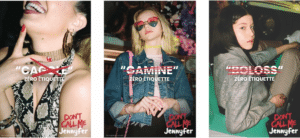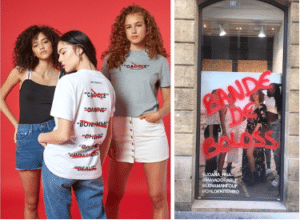What do Lidl, Decathlon and Jennyfer all have in common?
By reappropriating social phenomena, these brands have all shown a resolve to go over and beyond their retailer status. They have ultimately become… ‘lifestyle brands’. Here’s why.
1st lifestyle brand – Lidl: ugly is the new cool
Remember when in 2020, the retailer took the world by surprise by launching a collection of Lidl-branded sneakers, T-shirts, flip-flops and socks, etc. It created an immediate buzz with customers flocking to the stores: within minutes, all the sneakers were out of stock. In 2021, Lidl pulled off the same operation with Christmas jumpers. The characteristic features of these various products being their very low price (the sneakers were sold at only 12.99 euros), their limited quantity and… their unparalleled ugliness!
And while the consumer craze here can partly be explained by the demand-creating principle of scarcity, there’s another interesting explication. The reason why Lidl sneakers and similar products are so ugly is that they reflect a desire to pander to the conscious consumer who has chosen to reject the aesthetic canon: ugly is now the new cool, something the luxury industry knows too well… The fact that, since the launch of Balenciaga’s Triple S, we’re now seeing Ugly Shoes everywhere is proof enough: fashion no longer has to rely on conventional beauty standards!
Lidl: or how to be part of the counter-culture movement fueled by youths eager to reject aesthetic codes and diktats.

2nd lifestyle brand – Decathlon: normality as a difference
Decathlon, with its sports articles that nobody would be seen dead in otherwise? If this was ever the case, that time is now long gone! The influence of certain rappers has, or course, helped… There’s not only Orelsan with his camouflage outfit bought from the hunting section of Decat’, but also Jul with his characteristic Quechua down jacket: the new stars of French rap have taken to brandishing a ‘no frills’ style, leaving behind the bling-bling and ostentatiousness of big brand logos. References to Decathlon can even be found in their music: in his song JCVD, Jul raps the following: “In the pocket of my Quechua bag, flip-flops, coupons and a hair dryer / I just want to hang around in the evenings, but in life you have to make choices”. What music to the brand’s ears! Decat’ have been eager to capitalize on this successful newfound hype, particularly on social networks.
And in doing so, the brand has become the Mecca of ‘normcore’: a clothing movement characterized by the aesthetics of the normal and banal, which sanctifies the non-style and the functional, in order to be free of the tyranny of brands, or in other words, create a unique brand identity based on non-identity.
Decathlon: or how to surf the normcore trend (without even wanting to originally!).

3rd lifestyle brand – Jennyfer: how stereotype gives way to true identity
Until a few years ago, the Jennyfer brand suffered from a glaring image problem (i.e., poor quality, unattractive clothes sold either in stores in small provincial towns or in shopping malls in large cities, etc.). Moreover, stereotypes about people who shopped at Jennyfer were particularly virulent. The brand was seen as cheap, old-fashioned and uninspiring. And yet, in 2018, the brand achieved the impossible and successfully reinvented itself to become attractive to consumers. How did they pull this off? By making light of the very same clichés, using them to their advantage to effectively do away with them! This was reflected in both their particularly well-run ‘Don’t call me Jennyfer’ communication campaign, and their #ZeroEtiquette concept based on a very powerful idea: we are all free. We can impose our personality and style without having to worry about looking like a stereotype.
The reason why Jennyfer’s rebranding worked so well was that it spoke to the heart of the brand’s teenage target audience, showing that the brand was ultimately suffering from the same ills and challenges as the Gen Z and Millennials.
Jennyfer: or how to bounce back by embracing young peoples’ quest for identity, and helping wage war against stereotypes.


Why we love these brands:
While some other brands try to connect with their target market by any means possible, at the risk of it sometimes appearing as little more than an opportunistic nod to a cultural or social phenomenon, these three examples show that this is indeed possible and still remain coherent with their brand’s DNA. Lidl may have chosen to capitalize on the principle of scarcity and ugly fashion, two strategies well known to luxury brands, but they also offered extremely low prices. And that is what the brand has always done, i.e., offer unbeatable deals to its customers. Decathlon initially focused on technicality, with the promise of offering durability and functionality rather than style and a fashionable look. Decathlon chose to embrace normcore from the start. Lastly, Jennyfer elected to fully assume its heritage, holding on to its uncool name, and accepting its status as a low-end brand in order to free itself from its own label. The brand chose to be true to itself.
Sévan Sauvaget, Strategic Planner

